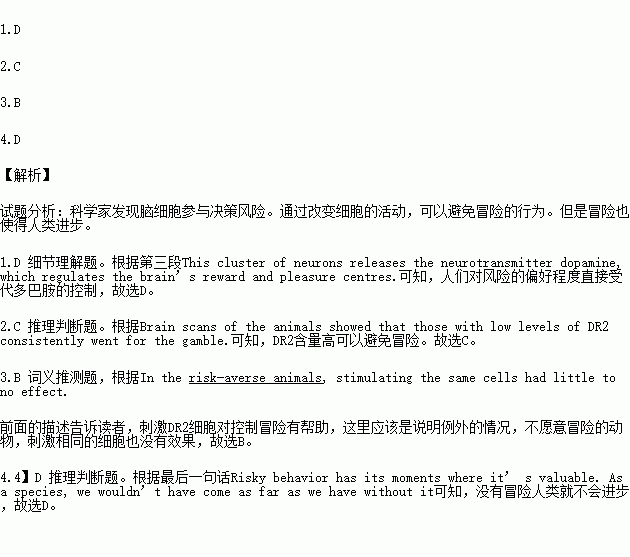题目内容
Scientists have exactly discovered the set of brain cells involved in making risky decisions, and have been able to control them in rats using targeted light. By changing the activity of the cells they were able to change the behaviour of risk-taking rats to avoid risk, hinting the approach could in future be used to treat people with impulse (冲动) control problems.
Risk-taking is a key part of survival, knowing when to take a chance could pay off—such as moving to a new area to look for food when pickings are slim.
While all animals need an element of risk, the preference towards it varies between individuals. Researchers found this variation, which determines how risk-averse an individual is, is regulated by brain cells in a region of the brain called the nucleus accumbens. This cluster of neurons releases the neurotransmitter dopamine, which regulates the brain’s reward and pleasure centres.
Previous studies have shown that in patients with Parkinson’s disease, taking medication which blocks specific dopamine receptors (DR2) (受体) leads to increased gambling (赌博) behaviour and risk taking behaviour. In studies with rats, researchers were able to use a technique called optogenetics (光遗传学)—which uses light sensitive proteins to change the activity of cells—to modify cells with DR2 in the nucleus accumbens.
Rats were trained to choose one of two levers, offering them a choice between a “safe” or “risky” choice. The safe option resulted in a small, but consistent amount of a sugar water treat. But the risky choice consistently delivered smaller amounts of sugar water, with the occasional large pay off—essentially encouraging the animals to gamble for a bigger prize. Around two-thirds of the animals weren’t keen on risk, opting for the safe option, but the remaining third were risk-seekers. Brain scans of the animals showed that those with low levels of DR2 consistently went for the gamble.
But using pulses of light to stimulate (刺激) the DR2 cells and improve their activity could cause the risk-takers to play it safe and opt for the guaranteed but less rewarding option. Once the light-pulses stopped, the risk-takers returned to their gambling strategy.
In the risk-averse animals, stimulating the same cells had little to no effect.
Professor Karl Deisseroth, of Stanford University in California, said: “Humans and rats have similar brain structures involved.”And we found a drug known to increase risk preference in people had the same effect on the rats. So every indication is that these findings are relevant to humans. “Risky behavior has its moments where it’ s valuable. As a species, we wouldn’t have come as far as we have without it.”
1.The variation in people’s preference towards risks is directly regulated by ________.
A. nucleus accumbens B. light sensitive proteins
C. neurons D. dopamine
2.From the experiment with rats, we can conclude that ________.
A. the lack of DR2 cells results in a safe option
B. the levels of DR2 have little to do with their choices
C. the high levels of DR2 can make animals avoid risks
D. the risky choice is a less rewarding option
3.The underlined words in Paragraph 7 most likely mean the animals that are ________.
A. willing to take big risks
B. reluctant to take risks
C. fond of gambling strategy
D. afraid of receiving stimulation
4.What can be inferred from what Professor Karl Deisseroth said?
A. Humans and rats differ in their preference for risk-taking.
B. Too much risk-taking can do more harm than good.
C. Risk-taking can be used to treat people with impulse control problems.
D. Risk-taking is a means of survival and brings higher returns to humans.

